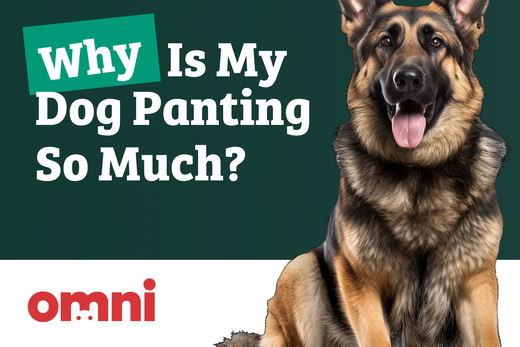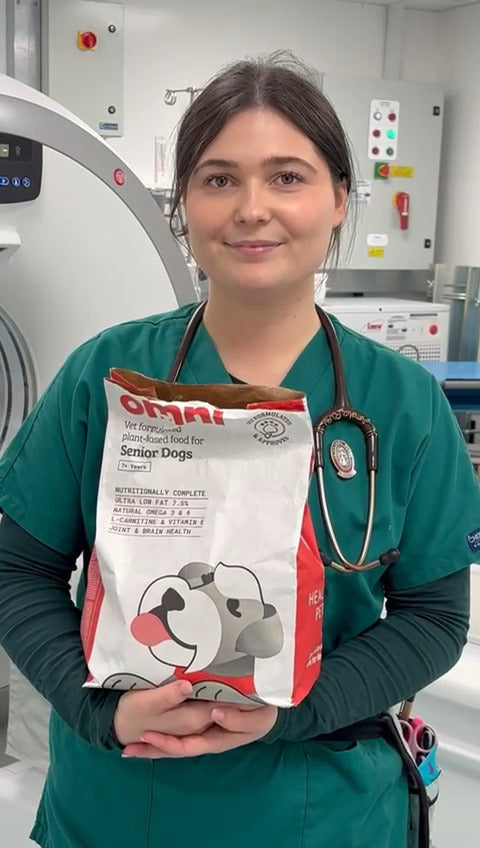Why Is My Dog Panting So Much? | Ask a Vet | Omni.pet

Why Is My Dog Panting So Much?
Laura from Manchester recently reached out, asking, “Why is my dog, Max, panting so much?”.
Max, a 10-year-old Border Collie, had been panting heavily for the past few days, even when resting indoors. Laura noticed that Max seemed more tired than usual and was drinking water more frequently, which made her concerned about whether something was wrong.
Panting is a normal way for dogs to cool themselves down, but excessive panting can be a sign of an underlying issue. If your dog is panting more than usual, especially when they’re not exerting themselves or it’s not particularly hot, it’s important to figure out why - for the good of your dog as well as your own peace of mind!
In this article, our Chief Veterinarian and Omni Co-Founder, Dr. Guy MRCVS, explains the potential reasons behind excessive panting and what you should do to help your dog.
Reasons Why Your Dog is Panting
Dogs pant for a variety of reasons, from regulating their body temperature to indicating pain or illness. Here are the most common causes:
1. Your Dog Might Be Overheating
Dogs primarily cool themselves through panting, which is a normal response to heat. Just like humans sweat (which draws heat out of the body as the evaporation of sweat helps to cool us down), dogs do the same thing through their tongue, since the rest of their body is covered in fur.
However, if your dog is panting excessively, especially on a hot day or after exercise, they could be struggling to regulate their body temperature.
How to Spot if Your Dog is Overheating
- Lethargy: Your dog may seem unusually tired or unwilling to move (even when you bribe them with “Walkies!”).
- Collapse: Severe overheating can cause your dog to collapse or become wobbly on their feet, perhaps losing coordination or stumbling into things.
- Wobbly or disoriented: Heatstroke can lead to weakness, stumbling, and confusion.
If you’ve suffered heat stroke before, remember how you felt and what symptoms you must have shown - your dog is not much different!
How to Help Your Dog Cool Down
- Provide a cool space: Ensure your dog has access to a shaded area and fresh water at all times. You can also offer cooling mats or fans to help them cool down faster.
- Seek veterinary advice: If your dog shows any other symptoms of heat exhaustion, such as lethargy or collapse, contact your vet immediately, as heatstroke can be life-threatening.
2. Panting Could Indicate Pain
Panting can also be a sign that your dog is in pain. Dogs, unlike humans, often mask their discomfort until it becomes too much to hide. Panting, along with other subtle signs, can be a way for your dog to signal that something is wrong.
Key Signs of Pain:
- Yelping or vocalising: If your dog yelps when you touch a specific area or when they move, they could be in pain.
- Guarding or protecting a sore area: Dogs in pain may avoid letting you touch a particular part of their body, such as their leg, abdomen, or back.
- Loss of appetite: Pain can cause dogs to stop eating, especially if the discomfort is internal or linked to dental pain.
What You Should Do:
- Seek veterinary advice: If your dog is panting excessively and displaying signs of pain, it’s important to have them examined by a vet. Avoid trying to examine sore areas yourself, as this can stress your dog and potentially worsen their condition.
- Rest and monitor: Ensure your dog is resting and avoid strenuous activities until you’ve consulted a vet.
3. Other Illnesses Can Lead to Panting
Panting can also be a symptom of underlying illnesses such as respiratory issues, heart disease, or even infections. If your dog’s panting is accompanied by other signs of sickness, it’s important to act promptly and seek immediate veterinary advice.
Key Signs of Illness:
- Lethargy: Dogs that are sick often become less active and may sleep more than usual.
- Loss of appetite: Not eating is a common sign that something is wrong, especially if your dog usually has a healthy appetite.
What You Should Do:
- Seek veterinary advice: If your dog is panting excessively and showing signs of illness, a vet visit is essential. Your vet will conduct a thorough examination and may recommend diagnostic tests to determine the underlying cause.
Summary of Common Reasons for Excessive Panting:
- Overheating: Look for signs of heatstroke such as lethargy, collapse, and disorientation. Provide a cool environment and fresh water. If symptoms worsen, seek urgent vet care.
- Pain: Panting could indicate discomfort. Watch for yelping, guarding of sore areas, and loss of appetite. Consult your vet for proper diagnosis and treatment.
- Illness: Panting alongside lethargy or loss of appetite may be a sign of a more serious condition, requiring immediate veterinary attention.
When to Contact a Vet
You should contact a vet if:
- Your dog is panting heavily without an obvious reason, such as heat or exercise.
- Panting is accompanied by other worrying symptoms like lethargy, collapse, or a lack of appetite.
- You’re concerned about your dog’s behaviour, but you’re unsure if it requires emergency care.
If you’re worried about your dog’s health, it’s always best to get professional advice. Book a free consultation with our vet team at Omni for expert guidance on what could be causing your dog’s excessive panting and how to manage it.
Thoughts from Dr Guy MRCVS
As dog lovers and guardians, it’s natural to worry about our furry friends, especially when they display abnormal symptoms that can’t be easily explained. That’s why, when I founded Omni, I knew that I wanted to keep vet consultation free and accessible at the heart of the business.
If you’re understandably worried about your dog, but you don’t think you need to take them to the vets urgently, I highly recommend getting some friendly, professional advice from one of our team.
Explore some of the frequently asked questions in our Ask a Vet series
Got a question for the Ask a Vet team?
Submit your question via email to woof@omni.pet. We’ll get back to you as soon as we can, and, if suitable, post the response here to help others, too!
Disclaimer: Whilst the advice given here is based on medical experience from our experts, and scenarios we do encounter during our career - we do not give tailored or specific advice for individual pets - please seek assistance from your in person vet as a first point of call with any issues your pet is having which are a cause for concern as soon as possible.







 85 Great Portland Street, 1st Floor, London, W1W 7LT United Kingdom
85 Great Portland Street, 1st Floor, London, W1W 7LT United Kingdom